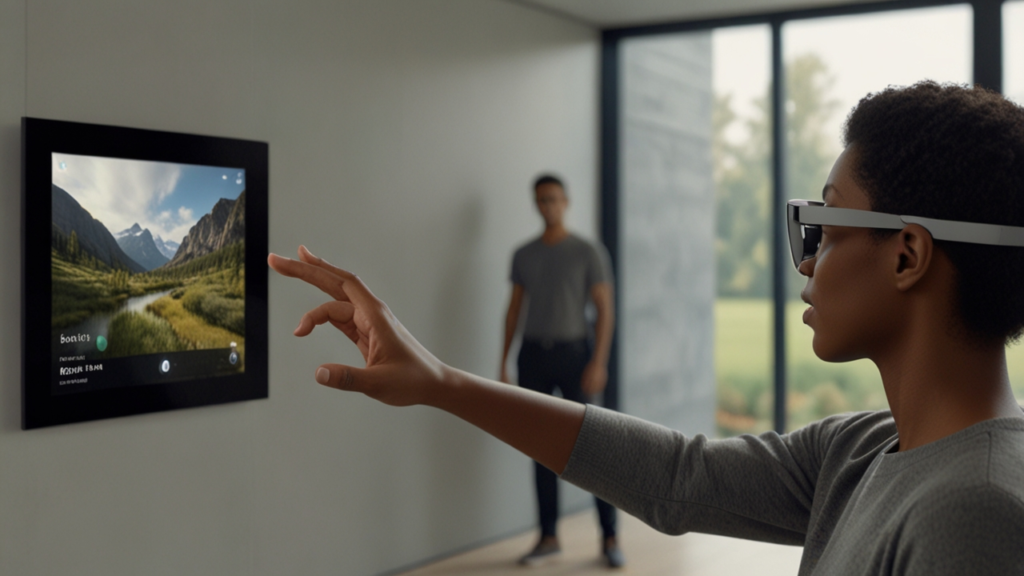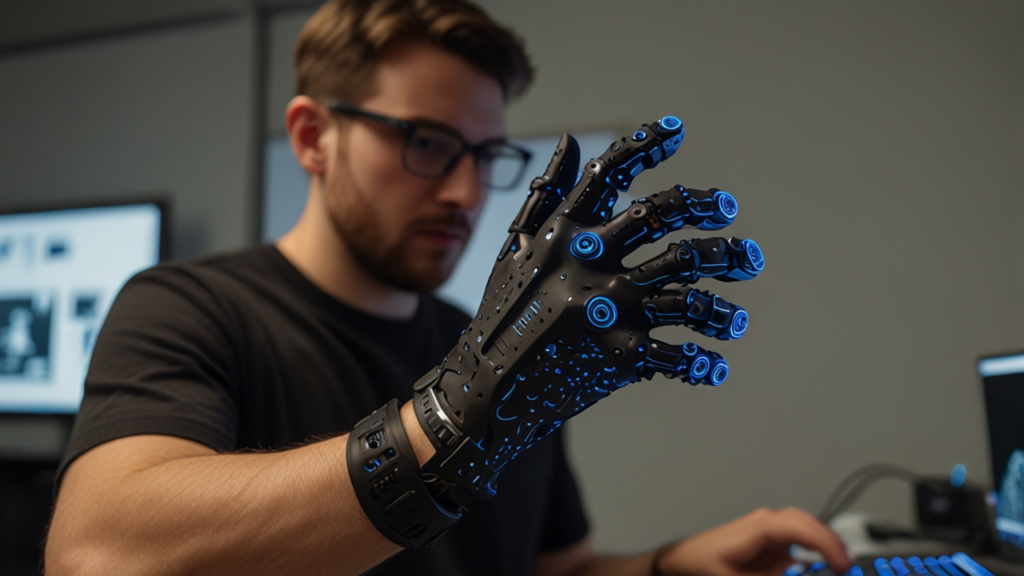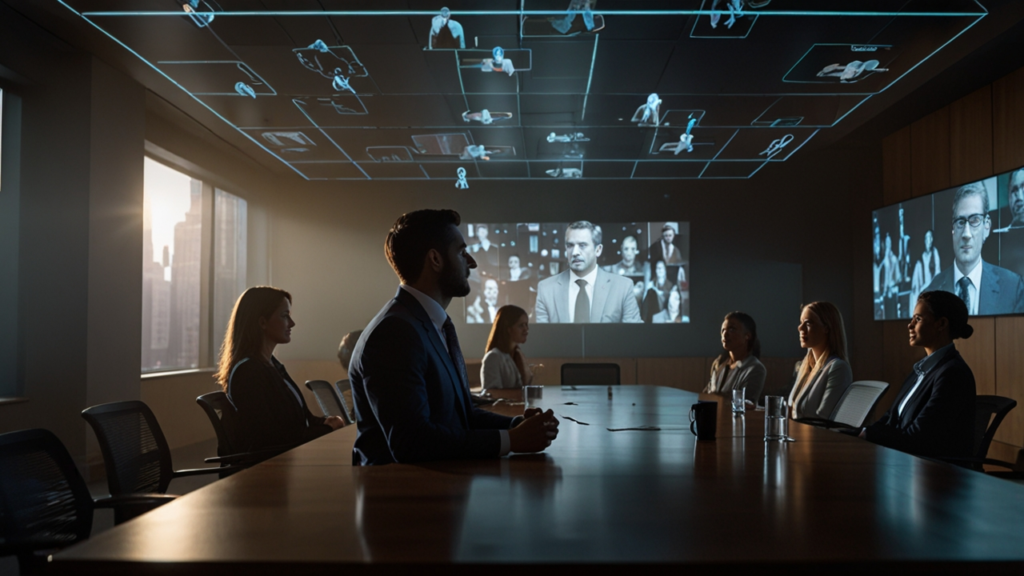Apple Vision Pro Experience 2025
The evolution of immersive technology has reached an exciting milestone with this cutting-edge device. Over the past few years, industry leaders have shaped the landscape and redefined interaction between the digital and physical worlds.
In 2023, a revolutionary device transformed the market by combining brilliant hardware, innovative software, and the strength of an integrated ecosystem. Today, we explore how this device is setting new standards in immersive experiences through its refined features and progressive improvements.
Now, we invite you to learn about the journey, technological breakthroughs, and real-world applications that have brought this device into the spotlight. Enjoy this in-depth exploration and share your thoughts as you read along.
Table of Contents
- Introduction to Apple Vision Pro
- Evolution and History of Apple Vision Pro
- How Mixed Reality Headset Enhances Apple Vision Pro
- Spatial Computing Systems and Their Applications
- Real-World Case Studies of Apple Vision Pro
- Immersive Display in Modern Apple Vision Pro Solutions
- Future Trends: Apple Ecosystem and Beyond
Introduction to Apple Vision Pro
For the latest updates and expert insights, check out Cutting-Edge Technologies.
Overview and Features
This device represents a breakthrough in digital interaction. It marries unprecedented resolution with a dual-chip design that pushes the boundaries of modern immersive tech. Under the hood, its micro-OLED display produces over 23 million pixels, delivering vibrant visuals that replicate natural reality. With the integration of carefully calibrated sensors and custom processing units, the user benefits from extreme precision and fluid motion tracking.
Apple’s approach has been unique: drawing on decades of experience across various products and platforms, the device combines advanced rendering with a controller-free interface. Its visionOS environment facilitates seamless hand gestures, eye tracking, and voice commands, ensuring intuitive interactions. A detailed study on this innovative design is available on Apple’s official product page.
Have you experienced a device that redefines how you interact with digital content?
Key Differentiators
The distinct capabilities of this device lie not only in its technical specifications but also in its revolutionary software ecosystem. What sets it apart is its ability to integrate digital content directly with your environment, a feature you seldom find in conventional gadgets. The lifecycle of this technology is built on significant milestones that have reimagined interaction modes.
Engineered with an impressive dual-chip architecture and an array of high-precision sensors, the device delivers reliable performance even in the most dynamic settings. Furthermore, its design emphasizes ease of use through natural gestures and minimal hardware interfaces. For more technical details, refer to the latest Apple newsroom update.
What unique user experience do you value the most in a digital device?
Evolution and History of Apple Vision Pro
Discover further insights at Smart Devices.
Historical Milestones
The timeline of this immersive device begins against a backdrop of rapid technological development. Early experiments in mixed-reality experiences paved the way for today’s advanced platforms. Pioneering products such as Microsoft’s HoloLens and Magic Leap One were instrumental in demonstrating the potential of merging digital content with reality.
In June 2023, the official unveiling of this device signaled a turning point in consumer-grade immersive technology. Its branding as a “spatial computer” showcased a shift towards a controller-free, natural interaction model. The device’s release is backed by groundbreaking micro-OLED technology and cutting-edge sensor arrays, as detailed in a news update on emerging models.
Which milestone do you think was the most critical in evolving immersive tech?
Technological Evolution
Underlying the device’s development is a robust history of technological innovation and iterative enhancements. Over the past two decades, the evolution from early augmented-reality experiments to a fully integrated spatial computing system has been remarkable. Each update introduced sophisticated elements like high-resolution displays and real-time sensor feedback mechanisms.
Engineers have focused on reducing latency and creating seamless interactions, employing proprietary chips and refined hardware calibration. The integration of software and hardware is a testament to the meticulous engineering involved. Detailed analysis from industry experts confirms the progressive improvements in processing power and efficiency.
How do you view the impact of technological evolution on everyday digital interactions?
How Mixed Reality Headset Enhances Apple Vision Pro
For more expert reviews, visit Future Devices.
Mixed Reality Integration
The device’s integration of mixed reality has redefined the user experience by merging digital elements with the physical world. With an intuitive interface guided by natural gestures, it eliminates traditional controllers, allowing you to interact directly through eye movement, hand gestures, and even subtle voice prompts. This direct mode of control is a major contributor to the device’s unique appeal.
Technical specifications reveal that the headset uses an innovative sensor system capable of real-time environmental mapping. The resulting spatial mapping ensures flawless overlay of digital content, thereby creating a more believable augmented experience. The harmony between software and hardware provides an efficient and immersive digital capability that almost feels tangible.
This synthesis of technologies underlies the device’s flawless performance. It is fascinating to consider how the fusion of hardware and software can alter the way you perceive reality. Could a future where digital and physical realms blend even more closely be on the horizon?
Impact of Sensor and Display Technology
At the heart of the device’s success lies a sophisticated combination of sensor arrays and display technology. Its micro-OLED panels push the visual boundaries with resolutions that exceed 4K per eye, delivering an immersive and lifelike view. Meanwhile, an array of cameras, LiDAR, and TrueDepth sensors captures physical space with unprecedented precision.
This sensor integration operates with ultra-low latency, ensuring that the overlay of digital layers on the real world remains seamless and responsive. The device’s dual-chip architecture plays a key role in managing extensive computational requirements for real-time interactions. For additional technical insights, consider the reported details available at reliable industry news.
What do you think is the most impressive technological feature driving immersive experiences?
Spatial Computing Systems and Their Applications
Learn more innovative approaches at Innovative Solutions.
Architecture of Spatial Systems
Spatial computing introduces the power of real-time digital mapping into everyday environments. At its core, this system anchors digital objects to physical spaces with remarkable precision. The underlying architecture leverages sensor data to create a continuously updated model of any given environment.
This advanced mapping enables dynamic interactions where digital content reacts and adapts to the real-world context. Such an arrangement is made possible through rapid data processing on specialized chips that ensure ultra-low latency responses. This architectural integration bridges the gap between virtual objects and tangible surroundings. Generally accepted industry standards affirm that this technology is transforming how designers and engineers create interactive experiences.
How could a better integration of spatial data improve your day-to-day technology use?
Applications in Various Industries
The power of spatial computing is not confined to entertainment—its applications span across multiple sectors including education, healthcare, manufacturing, and design. For instance, design studios are using it for 3D prototyping and virtual collaboration, while healthcare professionals rely on it for detailed surgical planning. This versatility demonstrates the system’s adaptability.
With immersive data visualization and interactive workflows, industries benefit from enhanced training and remote collaboration. These systems allow for creative problem-solving and real-time insights, encouraging efficiency and innovation. As a result, organizations worldwide are integrating these systems into their core operational strategies.
Can you imagine how these applications could reshape a field you are passionate about?
Real-World Case Studies of Apple Vision Pro
Stay ahead with insights from Tech Vision.
Enterprise and Developer Adoption
In the United States, enterprises across design, healthcare, and professional training have integrated this device into their workflow. Companies leverage it for immersive product visualizations and interactive training sessions, revolutionizing their operational procedures. Developers have also created specialized applications for real-time 3D modeling, further expanding the device’s capabilities.
Real-world case studies indicate that the device has improved project collaboration among remote teams. Enhanced by its precision tracking and controller-free interface, teams can interact with complex data as if it were a tangible object. This shift not only boosts productivity but also streamlines communication. These examples demonstrate how technology is redefining work environments, with detailed case studies presented on industry platforms and forums.
Have you ever encountered a situation where technology made collaboration significantly easier?
Global Case Studies and Culture
Across Europe, Asia, and Australia, diverse industries are experimenting with immersive technology. In Europe, architecture firms have used collaborative reviews via the device to create scale models in real-time, enhancing design accuracy. In Asia, leading manufacturers have adopted it for virtual prototyping and assembly line training, minimizing errors and increasing safety.
Meanwhile, hospitals in Australia have leveraged the device for telemedicine and remote diagnostics, showcasing its versatility. These global case studies reveal that cultural factors and regulatory environments can shape technology adoption in unique ways. Innovations continue to emerge from different regions, each contributing case-specific insights that collectively push the envelope of what immersive technology can achieve.
What cultural insight do you think influences technology adoption the most?
Comprehensive Comparison of Case Studies
| Example | Inspiration | Application/Impact | Region |
|---|---|---|---|
| Enterprise Collaboration | Enhanced Interaction | Improved training modules and product visualization | USA |
| Collaborative Design Reviews | Scale Modeling | Real-time 3D design feedback | Europe |
| Virtual Prototyping | Efficiency in Manufacturing | Reduced production errors | Japan |
| Remote Diagnostics | Telemedicine Advancements | Enhanced patient care | Australia |
| Interactive STEM Education | Engaged Learning | Improved student participation | UK/Germany |
Immersive Display in Modern Apple Vision Pro Solutions
Technical Insights into Immersive Displays
The device’s display system leverages state-of-the-art micro-OLED technology, offering resolutions that deliver lifelike visual quality. Each eye benefits from brightness, contrast, and color fidelity that far exceeds traditional displays. The integration of a dual-chip architecture ensures that processing and sensor data remain synchronized, allowing for smooth, immersive visual streaming.
Engineers have fine-tuned the display modules to minimize latency, making digital overlays appear natural and continuous. This innovation is instrumental in creating a more engaging experience for users. For technical reviews and specifications, consider reading additional reports on established technology journals.
How do you think a high-fidelity display can change your digital viewing habits?
User Experiences and Feedback
User feedback highlights that the immersive display has transformed how interactive content is consumed. Professionals report that the device makes virtual meetings feel more personal and enhances collaborative efforts by making data and graphics more tangible. Many users appreciate its ease of use and the clarity of visual details that merge digital overlays with real-world environments.
Focus groups have noted that the natural transition between digital elements and physical surroundings not only increases efficiency but also deepens engagement. The experience, described as “mirroring life itself,” continues to set benchmarks in visual performance and interaction. This feedback reinforces the device’s role in redefining modern workspaces and entertainment experiences.
Have you ever been captivated by the quality of a display so much that it changed how you work or play?
Future Trends: Apple Ecosystem and Beyond
Upcoming Innovations
Looking ahead, the roadmap includes several enhancements promising to elevate the immersive experience further. Rumors and preliminary announcements suggest that lightweight models, such as a rumored “Vision Air,” will soon become more broadly available. These models are expected to cater to a wider audience by offering improved portability and affordability.
Next-generation devices are set to integrate advanced AI capabilities along with improved sensor tracking and faster processing speeds. The continuous evolution of the ecosystem underlines the commitment to quality and innovation. Future updates may include refined gesture recognition, better environment mapping, and further reduced latency—all improvements that could reset industry benchmarks.
Do you envision these upcoming technologies transforming everyday interactions in your work or personal life?
Predictive Market Trends
Market analysts predict that immersive devices will soon become a staple across diverse sectors, driven by a convergence of software and hardware innovations. As the device matures, it is expected to influence enterprise training modules, entertainment options, and even remote healthcare solutions. The progressive integration of AI and enhanced sensor arrays will likely spur even greater enterprise adoption.
Economic forecasts indicate that the global market for immersive technologies is set to grow significantly, fueled by improvements in both affordability and performance. Such trends point to a future where these devices become integral components in everyday professional and educational settings. Future projections based on recent sales data highlight the competitive edge provided by continuous software updates and hardware refinements.
What market trend in technology excites you the most as we look to the future?
Design Beyond Boundaries
In a world where problem-solving meets creative exploration, design thinking has emerged as a transformative approach. It is about breaking free from conventional constraints and reimagining solutions that span across disciplines. This approach not only fuels innovation but also fosters a culture of experimentation where diverse ideas converge to create breakthrough solutions.
One of the most intriguing aspects of creative problem-solving is the emphasis on collaboration. Professionals from varied fields, including art, engineering, and psychology, come together to tackle challenges that were once thought insurmountable. The combination of different perspectives leads to insights that often result in elegant solutions. It involves iterative prototyping, frequent testing, and learning from failures to improve the next idea.
At its core, design thinking challenges established norms and encourages us to reframe problems. When individuals step back from daily routines, they can see challenges from a fresh vantage point. This process can lead to unexpected discoveries and inventive strategies that have the power to reshape industries. Authentic collaboration and open discussion are at the heart of this creative journey.
Even though the underlying principles of design thinking are simple, their execution can spark significant breakthroughs in everyday life. By embracing a mindset of perpetual curiosity and willingness to experiment, you can transform obstacles into opportunities. Ultimately, this art of creative problem-solving can inspire us to engineer a better future while maintaining a human touch in every innovation.
This perspective encourages us to push beyond the familiar and reimagine what could be possible tomorrow. As the boundaries between disciplines blur, creative solutions become the norm. Such a dynamic approach serves as both a catalyst and a reminder: the journey to innovation is as important as the destination.
FAQ
What defines the innovative design of this device?
The device is defined by its integration of high-resolution displays, advanced sensor arrays, and a controller-free user interface. It leverages decades of technological expertise to merge digital content seamlessly with physical reality.
How has the evolution of immersive technology contributed to its current design?
Over the past two decades, continuous improvements in micro-OLED displays, chip architectures, and sensor technologies have redefined the immersive experience. Each technological milestone has paved the way for a more intuitive interface and richer visual content.
Why is spatial computing important for digital experiences?
Spatial computing allows digital content to be mapped onto real-world spaces, creating interactive and context-aware experiences. This integration has opened up a new realm of applications across education, healthcare, design, and more.
What applications are driving enterprise adoption of immersive technologies?
Enterprises are using these technologies for immersive product visualization, detailed training modules, and remote collaboration. The ability to interact with 3D models in a real-world context has proved especially valuable in design and healthcare sectors.
How do you see future trends shaping the evolution of this technology?
Future trends point toward lighter models, enhanced AI integration, and broader consumer adoption. Continuous improvements in sensor technology and processing speeds will further solidify these devices as essential tools across multiple industries.
Conclusion
This comprehensive exploration of the device’s journey—from its groundbreaking technology to its future potential—demonstrates a powerful blend of innovation and practicality. Throughout the article, we have seen how each advancement is not only a technological marvel but also a stepping stone to transforming daily experiences in work, education, and beyond.
The fusion of digital and physical realms marks the beginning of a new era in immersive technology. As you reflect on these developments, consider how such innovations might change the way you interact with your environment. Your insights and experiences matter, and we invite you to share your thoughts.
For more information on this dynamic subject, please visit our Mobile & Gadgets category or Contact us directly.
Have you experienced a moment when technology truly transformed your daily routine?



